Readers Write 2021
Wisconsin Natural Resources magazine encourages reader photos and feedback. Below, you will find letters that appeared in 2021 magazine issues. Reader letters from other recent years are available here:
Reader letters and other content from older issues of Wisconsin Natural Resources are part of the magazine archives housed in the UW-Madison Libraries Digital Collections [exit DNR]. (Note: Magazine content from 1996 and newer is being added to the UWDC site, so some of those years may be temporarily unavailable.)
We welcome your feedback! Email us at dnrmagazine@wisconsin.gov or mail to:
Readers Write
WNR magazine
PO Box 7921
Madison, WI 53707
Summer 2021
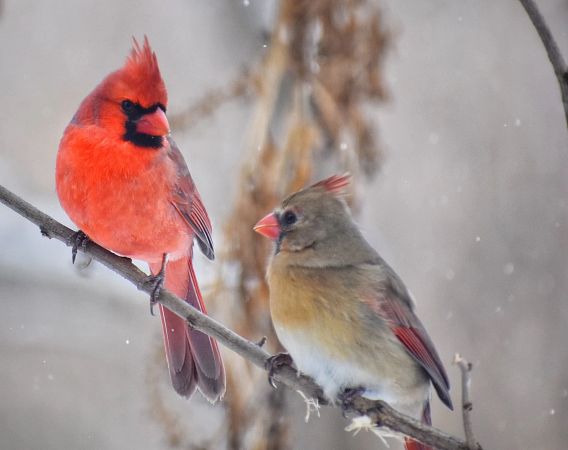
MR. AND MRS. CARDINAL
A beautiful northern cardinal pair, perched together in my back yard. Taken in Richland County.
Jackson Kinney
Blue River
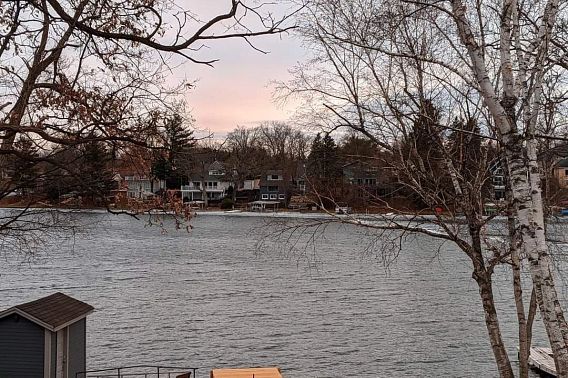
TIMELY TALE OF LAKE LIFE
I just read the Spring 2021 issue cover to cover! My husband and I recently moved to Lake Okauchee. The ice has just come off the lake. Ted Rulseh’s article on “Lake Awakenings” was so timely. I ordered his book. Thank you for a great issue and all the wonderful work the DNR does.
Elaine Jacobsen
Oconomowoc
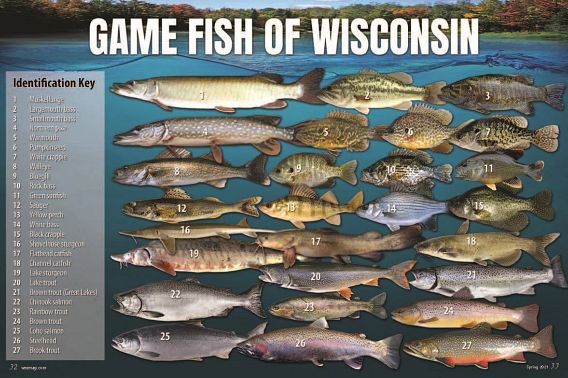
GAME FISH A BIG HIT
I just wanted to congratulate the staff of Wisconsin Natural Resources for producing the Spring 2021 edition. It is the best one I have seen. Photography and writing were excellent.
I also wanted to ask if there is someplace I can buy or obtain a poster of the Game Fish of Wisconsin pictures that appeared in the issue. A number of years ago, I obtained a poster you had published and have it mounted at my lake home in Shawano. … Keep up the good work.
Greg Martin
Addison, Illinois
Thanks for the kind words! Several readers asked about the “Game Fish” piece from the Spring issue. Unfortunately, it is not available as a full-size poster at this time, but the magazine was designed so those pages, printed on a bit heavier paper, could be easily removed and saved.
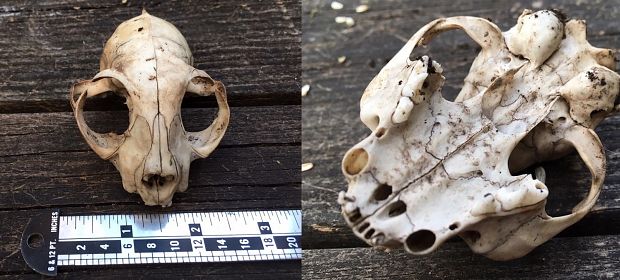
TEETH HOLD THE CLUE
I found this skull while cleaning up a perennial flower bed in my yard in May 2019. Can you please tell me what it is? This is a rural area of Fitchburg with plenty of woods, farm fields and critters! Thank you.
Anita Clark
Fitchburg
Wildlife biologists Rich Staffen and Paul White, both small mammal experts for the DNR, agreed on the ID. Here is Staffen’s reply: “I believe it is a striped skunk. This is based off the dental formula from the second picture, which appears to be three incisors, one canine, three premolars — missing the first; second and third are somewhat combined, but two roots — and one large molar, angled. But it’s also based on the size and shape of the top of the skull.”
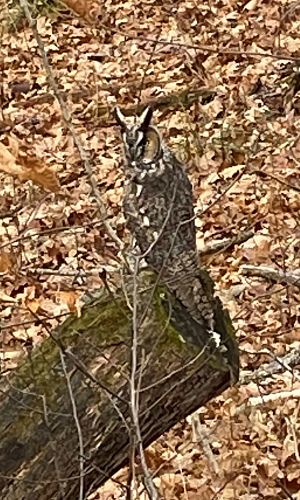
IN FACT, THAT’S A LONG-EARED OWL
On page 59 of the Spring 2021 issue, there’s a photo of an owl identified as a great horned owl. It’s a small photo, but it looks more like a long-eared owl to me, which would be a rarer owl to see.
Pat Wilson
La Crosse
Looks like the owl is actually a long-eared owl in a “scared” pose. You may want to have Ryan Brady check it out.
Thomas Goltz
Wausau
Good catch by these two readers and others who asked about the owl. DNR conservation biologist and bird expert Ryan Brady notes: “This is indeed a long-eared owl, which is a smaller, slimmer and less robust owl than the great horned. Also, the ‘ear tufts’ — which aren’t ears at all — are proportionately longer and set closer to each other than in the great horned owl. The reader’s reference to a ‘scared pose’ is accurate. When alarmed, most owls flatten their feathers to become slimmer, more erect and, hopefully for them, more difficult to see.
“Long-eareds are uncommon to rare in most areas of Wisconsin, especially during nesting season. In nonbreeding season from October to April, small numbers overwinter in mostly the southern half of the state. Where numbers are sufficient, they are known for communal winter roosts of five to 25 or more birds. These roosts are sensitive to human disturbance and may be abandoned if visited frequently by birders, photographers or an unknowing public.”
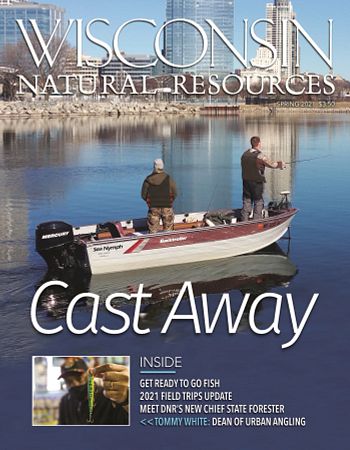
FLY FISHING FAN WEIGHS IN
First, the compliments. I find the “new” version of WNR to be quite satisfactory and offer my congratulations on a publication that’s maintained its high standards and produced issues that are eminently readable, interesting and informative.
However, as a lifelong devotee of fly fishing, I feel compelled to point out its absence in the DNR staff authored “Gear Up to Go Fish” article of the Spring issue. … Although fly fishing is often associated with Wisconsin’s trout stream fishery, the method is now applied to everything from muskies to carp to panfish.
Fly fishing was “invented” long before spincasting, spinning or baitcasting. In fact, the only type of rod angling that’s older than fly fishing is likely the cane pole itself.
E.R. Waskawic
Omro
Thanks for the note, and you are right about the longevity of fly fishing. Requiring a bit more finesse than other types of angling and sometimes challenging for beginners, fly fishing is certainly something we’d love to include more about in future issues.
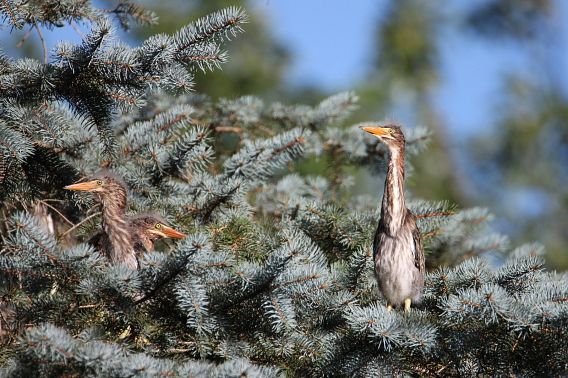
HAPPY HERONS
We had fun watching a family of green herons being raised in our back yard. It was interesting tracking their development from hatchlings until they left the nest. As they matured, they would go from branch to branch, tree to tree, waiting for their parents and exploring the world around them. Upon leaving the nest, they found our ornamental pond to be very interesting. Our goldfish were not amused!
Jim and Nancy Jazdzewski
Stevens Point
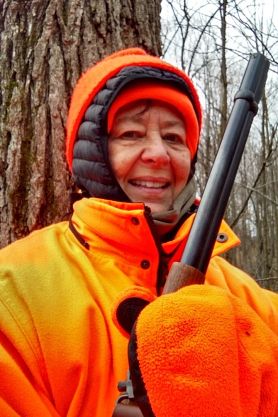
YES TO THE HUNT
I was happy to see the article in the recent issue about female deer hunters (Fall 2020). I know we are in the minority, but our numbers are growing. 2020 was my 50th consecutive year gun hunting and my 40th consecutive year bow hunting for deer. I was determined to get a buck last year, and I succeeded after 30 hours in my stands.
It wasn’t a trophy as far as points go, but it was a trophy to me as a celebration of 50 years of hunting. I love spending time in the woods. I love the peace and solitude and enjoy seeing the wildlife. Years ago, bought the book “Is She Coming Too? Memoirs of a Lady Hunter,” by Frances Hamerstrom, and all I can say is,“Yes, I am!”
Mary Roen
River Falls
Spring 2021
Spring 2021
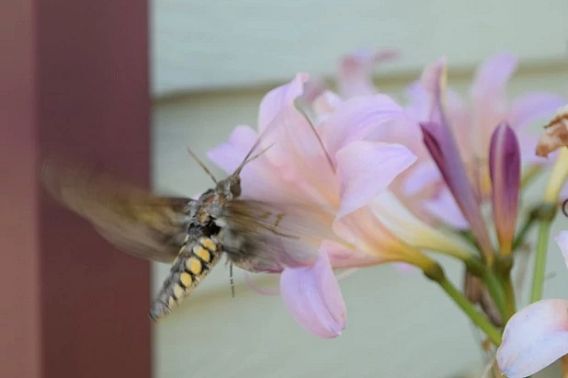
MOTH DRAMA, FOR A MOMENT
Included is a picture taken the third week of August of a sphinx month feeding among our surprise lilies. There was a moment of drama when it got caught on the strong supporting web of a spider web running from the house to a hummingbird feeder post. It couldn't get free, so I broke the web.
The moth just fluttered down into the foliage. It still had remnants of the web impeding its flying. It took just one pull to free the moth completely, and it was up happily feeding away again just moments later. It's easy to see why these moths are sometimes confused for hummingbirds!
Gary Alseth
Footville
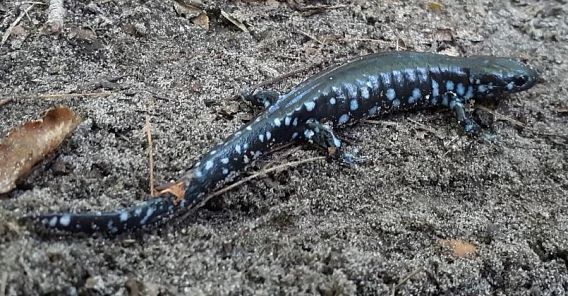
SALAMANDER SPOTTED
We were delighted to meet this blue-spotted salamander while hiking a northeastern trail on Washington Island in September. It was about 5 to 6 inches long. At first, we thought it was dead, but after a little gentle stick nudging, it twisted and flipped around and around, biting the stick a few times.
Surprised and laughing, we backed off to admire its spunk. This little guy certainly made our day!
Sue Allen and Bruce Dethlefsen
Westfield
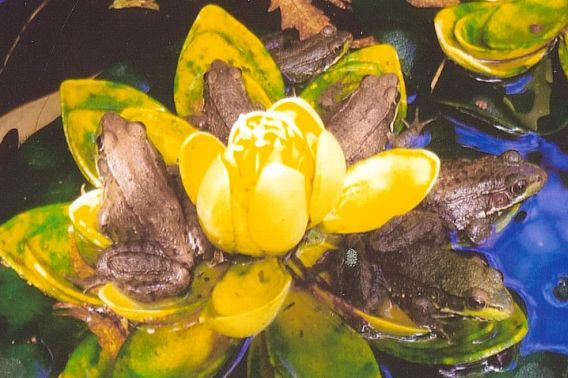
FROG CIRCLE OF FRIENDS
I didn’t pose these guys. They lived all summer in my 35-gallon backyard pond. Some days their friends would stop by, and I could count up to 13 wood frogs. This proves even a small habitat can matter.
Barb Schaefer
Glenbeulah
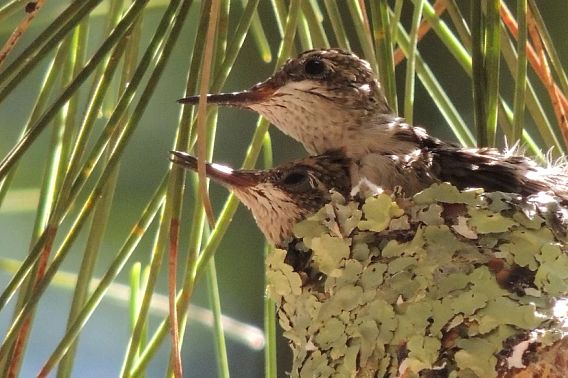
FOCUS ON HUMMINGBIRDS
My uncle, Robert Strand, said I should submit these photos. They are of a hummingbird nest on Pickerel Lake in Eagle River. I was tying fishing lines at my truck, and this hummer kept coming by to look at me. When I went to the garage, I heard her fly up to a nest! Got to watch them grow for a week.
Rich Holly
New Berlin
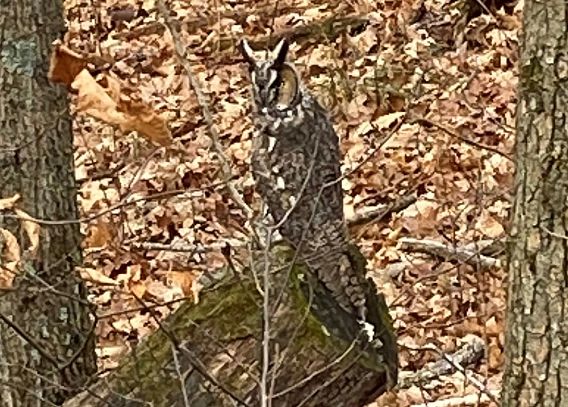
THE EYES — AND OWLS — HAVE IT
I was thrilled to nab this great horned owl pic while deer hunting near Greenbush in Sheboygan County. What first stood out were his eyes. If not for them, I probably wouldn’t have noticed. He wasn’t threatened by me, so I got to hang out with him a few minutes.
Steve Meifert
Plymouth
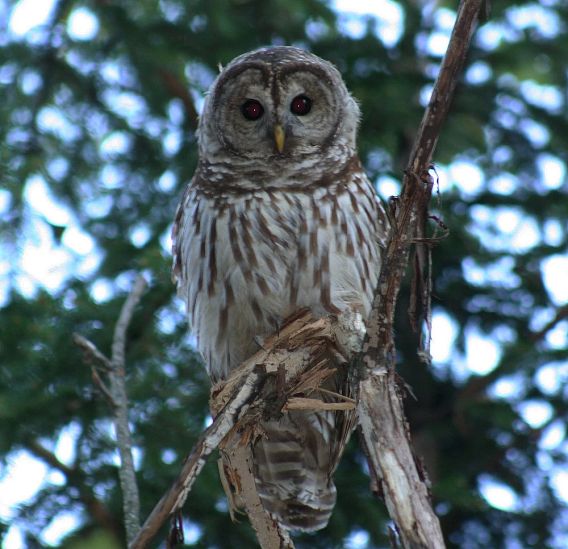
While I was trying to revive an old DSLR camera, a barred owl landed nearby and watched the entire time it took me to get the old rig working. The shot was taken in Wood County, not far from Buckhorn State Park.
Mike Crain
Waukesha
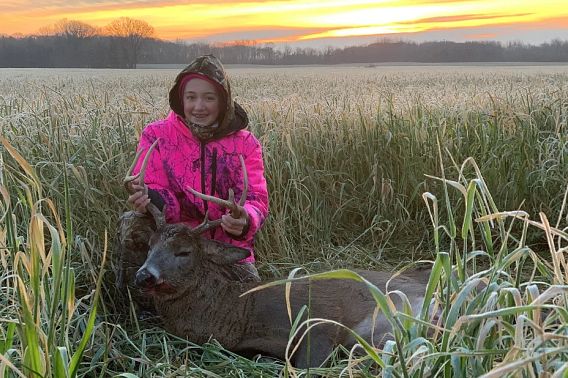
MOST MEMORABLE MENTOR HUNT
I took my 13-year-old daughter, Alexia, gun hunting and was mentor hunting with her when we spotted a buck grazing about 300 yards away. Just four minutes after legal shooting time began, I called the buck with a grunt tube, and the buck turned and walked straight to us. Lexi shot from a distance of 104 yards and got her first deer.
This was by far the most memorable mentor hunt I have had. Just wanted to share the story and a picture of her with the buck.
Paul Olsen
Sheboygan
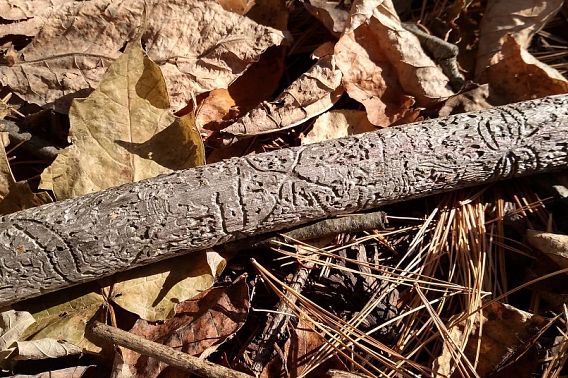
INSECT ARTWORK
My wife, Barb, was out hiking in Ash Creek Community Forest in Richland County when she spotted this oddly marked branch. At first, she thought someone had carved it. But upon closer examination, she realized the hieroglyphic-like markings were made by insects.
Len Harris
Richland Center
The “Wisconsin Bug Guy,” PJ Liesch of UW-Madison’s Insect Diagnostic Lab, replies: “This appears to be the work of bark beetles. Bark beetles (family Curculionidae, subfamily Scolytinae) are a very diverse group of insects with hundreds of species across the U.S. While some species can be a bit more aggressive, such as the mountain pine beetle out West, many bark beetle species are commonly associated with dying or stressed trees.” Learn more about bugs and the Insect Diagnostic Lab at: insectlab.russell.wisc.edu.
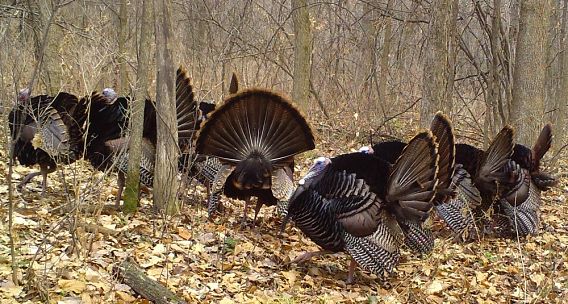
JUST IN TIME FOR THANKSGIVING
Wild turkeys, Nov. 20 from my husband's trail camera. They really are beautiful birds.
Gloria Troester
River Falls
HUNT HARE ALL YEAR
The Winter edition of WNR magazine contains some info that needs a bit of clarification. The Taste of Wisconsin story states “… you can hunt rabbits from September or October … through the end of February. With a daily three-rabbit bag limit, you've got potential for a pretty good hunt." This is accurate for cottontail rabbits, but snowshoe hares may be hunted statewide, year-round, and have no daily bag limit.
Scott Humrickhouse
Altoona
Editor’s note: Scott was secretary’s director for the DNR’s West Central Region before retiring in 2012. Thanks for helping us set the record straight on rabbit and hare hunting seasons. Complete hunting rules, including season dates and bag limits, can be found at: dnr.wi.gov/topic/hunt/regulations.
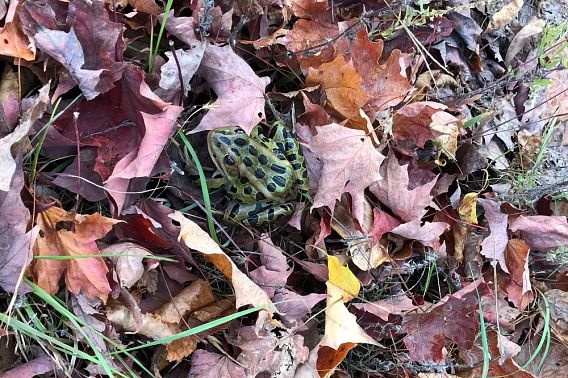
CAN YOU FIND THE FROG?
We play a game of “can you find me,” where I send our grandchildren photos of wildlife and they try to spot them in their natural habitat. This northern leopard frog was cached, out in the open, by Weber Lake in Iron County.
Bryan Lammers
Upson
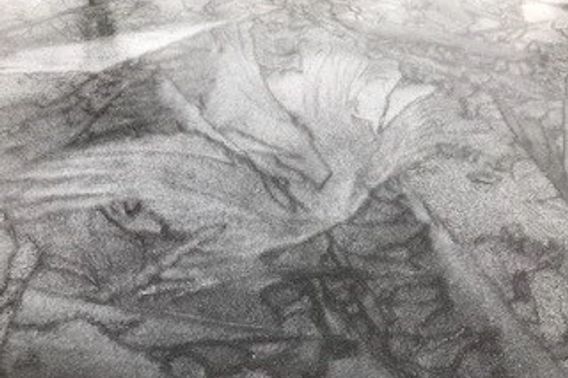
EAGLE ON ICE
I found this “eagle form” in the unusual early lake ice near Merrill. Thought it pretty neat.
Don Evans
Merrill
RECALLING A ‘GENTLE GIANT’
I enjoyed George Knudsen's reprinted article on winter nature hikes in the Winter magazine. I worked for the DNR from 1971-78 and knew George when he was the naturalist with state parks in the Pyare Square Building in Madison. He was a gentle giant.
When my wife and I were buying a canoe, I went down to see George in his office for his recommendations, and he told me about the benefits of a good Grumman canoe. George was a wonderful representative for the DNR and a wealth of knowledge about natural resources. Hope you will continue including some of his writings in the future.
Tim Eisele
Madison
Editor’s note: Thanks, Tim, and you are right about George Knudsen and many others who have been great representatives for the DNR through the years. When possible, we are happy to highlight him and others such as Anita Carpenter, who is featured in this issue’s Back in the Day, and Jerry Perkins, whose fish tale is told in Your Outdoors. Their work on behalf of Wisconsin’s natural resources is not forgotten.
SON CHERISHES THE MEMORIES
Thank you so much for the recent DNR magazine with my dad’s article on winter hiking! It brings back some memories of hikes with him at that glorious time of year — along the Wisconsin River, at Governor Dodge State Park, Black River State Forest, etc. We always did the Christmas Bird Count on New Year’s Day as well, a unit with Prairie du Sac as its epicenter. Many frigid days spent doing that! So many memories.
Brad Knudsen
Sun Prairie
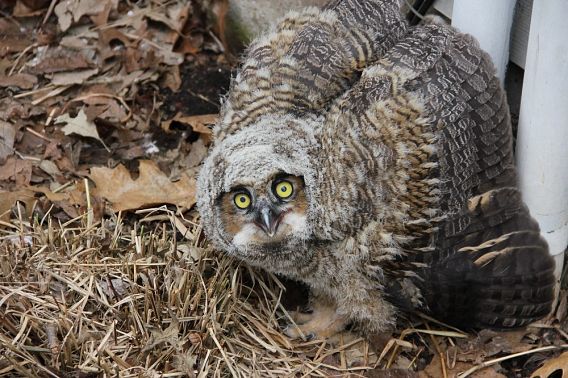
LOOK WHO’S AT THE DOOR
I live in Fitchburg in a wooded residential subdivision called Seminole Forest. A few years ago when I opened the back door to let out our dog, I was stunned to see this fledgling owl — I believe it is a great horned owl — cowering against the back of our house.
We were concerned for the young owl's safety, so we contacted the Fish Hatchery DNR office for guidance. They told us to stay clear of the bird. It had most likely been “evicted” from the nest and would fly off in due course. Sure enough, after two days the owl was no longer to be seen.
Through the years, I have often sat in bed and listened to the neighborhood owls communicate. One afternoon, I was even lucky enough to see an owl swoop down and take a rabbit. The owls have not been around for the past two years. Apparently, they have found a better hunting ground. I really enjoy your magazine and even provided it as a Christmas gift for my daughter, an avid Wisconsin hunter and angler, this past year. Keep up the good work.
Ken Lutz
Fitchburg
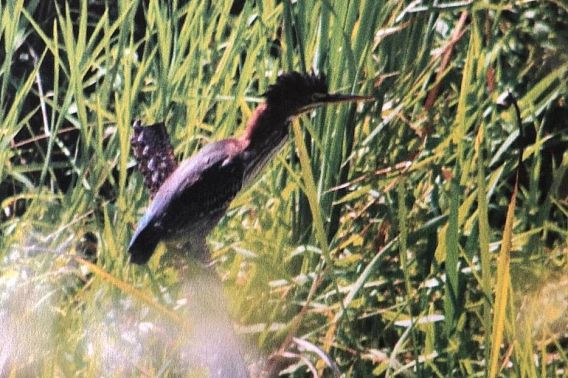
NO EGRET
This photo shows a reddish egret near Verona last summer. I believe this is a rare sighting of this bird. Let me know what you think.
Charles Schneeberg
Madison
Ryan Brady, DNR conservation biologist replies: “That’s a green heron, which is a small, somewhat common heron of Wisconsin wetlands, especially in the southern two-thirds of the state.”
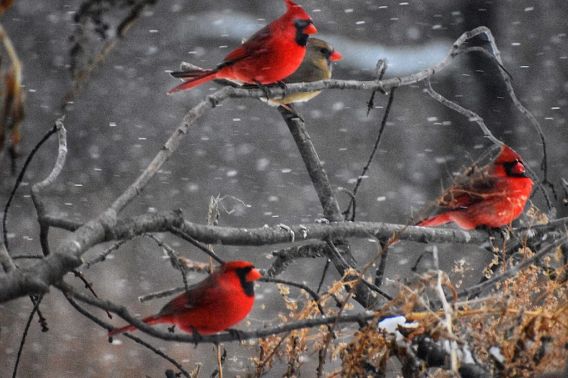
SNOW DAY FOR CARDINALS
I captured these photos of northern cardinals in my Richland County back yard. They’re one of my favorite birds to photograph, especially during a Wisconsin snowstorm.
Jackson Kinney
Blue River

